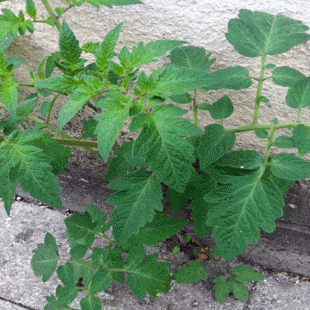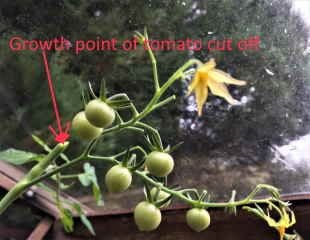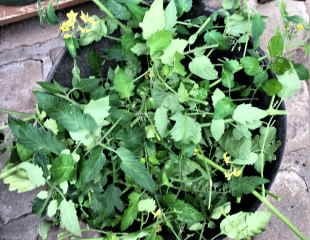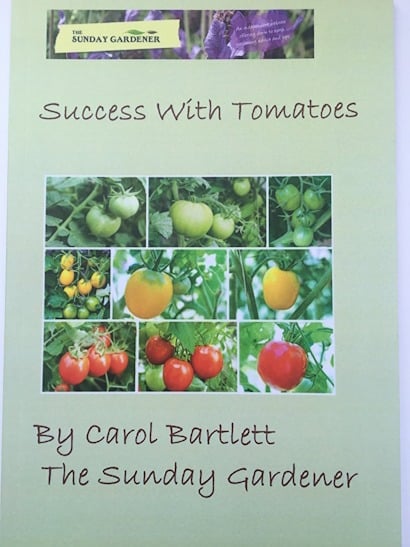How and why is it important to "Stop off "tomato plants
Left to their own vigorous devices, tomatoes will grow and grow, sprouting more branches, getting taller and taller with a mass of leaves. This extensive growth will be at the expense of the flowers and fruit. To get a good crop, it is necessary to constrain the plant, and this is how we do it.
When is the best to stop off tomatoes?
I’d love to suggest a specific date, as that would make things easier for everyone—especially new gardeners. The challenge, however, is that every growing season is different, and even tomato plants of the same variety can behave differently. Instead, it’s best to follow a few guiding principles to help you decide the right timing:-
Stop off at the top of the plant when there are 3-4 (outside-grown) and 4-5 (greenhouse-grown) trusses, which are layers of flowers.
The exact timing of when to stop the plant growing depends on when it has set enough trusses, which depends on growing conditions.
This usually occurs around August or September, (depending on where in the country your garden is, and the growing season.) This means pinching out the growing tips at the top of the plant to stop the plant from growing up any further.
It is usually necessary to continuously take out the growing points because the plant will strive to keep growing upwards.
Why stop off tomatoes?

Tomatoes are really vigorous plants.
If you’re wondering just how tough tomatoes can be, take a look at the one in the image—thriving in the tiny patch of soil inside a pavement crack in the city centre. That plant likely started from a seed dropped from a sandwich!
To concentrate the plant's energy in producing flowers and fruit, we stop the top growth and remove superfluous shoots and leaves. By pinching out the top growth, you are restricting the plant.
How to stop off tomatoes?

In this image, the plant has actually reached the top of the greenhouse roof and is resting on it. Above the flower is the pane of glass forming the top of the roof, so the tomato plant has reached the roof and developed the maximum number of trusses.
The arrow points to the cut-off growth point. Within a couple of weeks, shoots will appear alongside the cutoff point as the tomato attempts to regrow; cut these off as well. The process of cutting off the top growth continues throughout the latter part of the growing season to check the plant.
Thin Out Leaves

It is also necessary to thin out the tomato foliage, which get out of hand as the season goes on and diverts the plant's energy into leaf making, not fruit making.
Toward the end of the season, the plant shouldn't have masses of leaves on it. Be bold, cut some off. At the peak of the growing season, I remove lots of leaves each week when checking the tomatoes. The image shows a trug full, and I may cut this amount off, towards the end of the growing season, every week to 10 days. This also aids ventilation, which helps to reduce the risk of diseases.
What about the flowers? Toward the end of the season, you will have to decide which flowers will come to maturity, and which to sacrifice in order to get the other flowers and fruits to mature. It depends on your growing conditions. When you feel the season is slowing down, and light levels are starting incrementally to fall, there is only limited time left for the fruits to swell and it's better to concentrate on a few fewer fruits, as not all will mature. Remove all flowers and tiny fruits that will not have time to mature.
Step-by-step guide
How to grow tomatoes from seed and what to do about weedy seedlings
What are the easiest tomatoes to grow? Cordon or Bush?
How to pot on tomatoes, dos and don'ts, and why it is important.
Hardening off tomatoes for growing outside
Pinching out Side Shoots on tomatoes
The Best way to Water and Feed Tomatoes
How to ripen Green Tomatoes
Common pest and diseases when growing tomatoes

Success with Tomatoes
If you have found these tips helpful, why not buy the book: click here for details Success with Tomatoes The Sunday Gardener's guide to growing tomatoes, packed full of practical tips and helpful images, everything you need to know to grow a tasty crop. Was £6.20 now £4.20 plus postage UK only.

